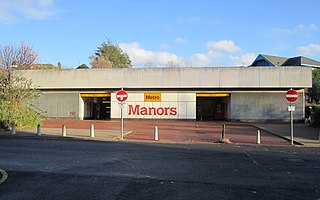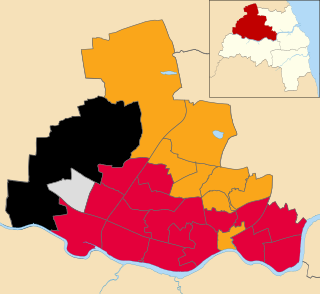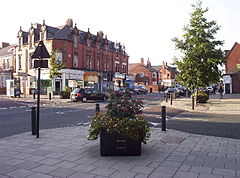
Newcastle upon Tyne East and Wallsend is a constituency represented in the House of Commons of the Parliament of the United Kingdom. It elects one Member of Parliament (MP) by the first past the post system of election.

Walker is a residential suburb and electoral ward in the south-east of Newcastle upon Tyne, in the county of Tyne and Wear, England.

Walkergate is an area and electoral ward in the city of Newcastle upon Tyne, England. It is in the east of the city, north of Walker proper, east of the Heaton area and west of Wallsend. Areas within the Walkergate ward include Daisy Hill, Eastfield, Walkerdene and Walkerville. Walkergate Metro station which was opened in 1982 serves the area. This replaced the previous railway station on the same site which was originally known as Walker station from 1839 to 1889 when it was renamed Walker Gate station.

Newcastle City Council is the local authority for the city of Newcastle upon Tyne in the ceremonial county of Tyne and Wear in North East England. Newcastle has had a council from medieval times, which has been reformed on numerous occasions. Since 1974 the council has been a metropolitan borough council. In 2024 the council became a member of the North East Combined Authority. The council is based at Newcastle Civic Centre.

Byker is a district in the east of the city and metropolitan borough of Newcastle upon Tyne, in the county of Tyne and Wear, England. Home to the Byker Wall estate, made famous by TV series Byker Grove, Byker's population was recorded at 12,206 in the 2011 census. Byker is bordered by Heaton to the north and by Shieldfield to the north east. Until 1974 it was in Northumberland.
Newcastle City Council elections are generally held three years out of every four, with a third of the council being elected each time. Newcastle City Council is the local authority for the metropolitan borough of the Newcastle upon Tyne in Tyne and Wear, England. Since the last boundary changes in 2018, 78 councillors have been elected from 26 wards.

Newcastle upon Tyne East was a constituency of the House of Commons of the UK Parliament. It was held by Nick Brown, an independent formerly of the Labour Party, from its recreation in 2010 until its abolition for the 2024 general election.

The Ouseburn is a small river in Newcastle upon Tyne, England that flows through the city into the River Tyne. It gives its name to the Ouseburn Valley and the Ouseburn electoral ward for Newcastle City Council elections.
Dene is an electoral ward of Newcastle upon Tyne in North East England. The ward takes its name from the nearby gorge at Jesmond Dene. Contained within the ward are government offices of the Department for Work and Pensions and the Freeman Hospital. The population of the ward is 9,554, increasing to 9,667 at the 2011 Census, 3.7% of the total population of Newcastle upon Tyne. Car ownership in the area is 74.8% much higher than the city average of 54.7%.

Manors is a Tyne and Wear Metro station, serving the Shieldfield area in Newcastle upon Tyne. It joined the network on 14 November 1982, following the opening of the fourth phase of the network, between Tynemouth and St James via Wallsend. The station is located near to Manors National Rail station, which is on the East Coast Main Line. However, the stations are not directly connected.
East Gosforth also known as Gosforth East is a former electoral ward in Newcastle upon Tyne, Tyne and Wear, UK. It was created in 2004. The population of the ward is 8,981, increasing to 10,145 at the 2011 Census, 3.5% of the total population of Newcastle upon Tyne. Car ownership in the area is 68.8%, higher than the city average of 54.7%. It was formerly one half of Gosforth's wards, along with the West Gosforth ward.

Benfield School is a coeducational secondary school located in Walkergate, Newcastle upon Tyne, England.

Jesmond is a suburb of Newcastle upon Tyne, Tyne and Wear, England, situated north of the city centre and to the east of the Town Moor. Jesmond is considered to be one of the most affluent suburbs of Newcastle upon Tyne, with higher average house prices than most other areas of the city.

Jesmond Vale is a town located in Newcastle upon Tyne, England. situated in the Ouseburn Valley, an area with diverse fauna, mature trees, and a rich history of industrial archeology. The surrounding areas are commonly used for entertainment and outdoor activities.

The 2016 Newcastle City Council Council elections took place on 5 May 2016 to elect one third of the members of Newcastle City Council in England. The elections took place on the same day as other local elections.

The Byker Viaduct is a 2,674 ft (815 m) curved S-shaped light railway bridge, which carries the Tyne and Wear Metro over the River Ouseburn in Newcastle upon Tyne. It carries the line from Manors Metro station in the city centre to the west, to Byker Metro station in the area of Byker to the east, over the lower Ouseburn valley, with the river emptying into the north side of the River Tyne, to the south. It was one of two major bridges built specifically for the Tyne and Wear Metro, the other being the Queen Elizabeth II Bridge crossing the River Tyne.

The 2019 Newcastle City Council elections took place on 2 May 2019, on the same day as other local elections across the United Kingdom.

The 2021 Newcastle City Council election took place on 6 May 2021 to elect members of Newcastle City Council in England. This was on the same day as other local elections across the United Kingdom.



















